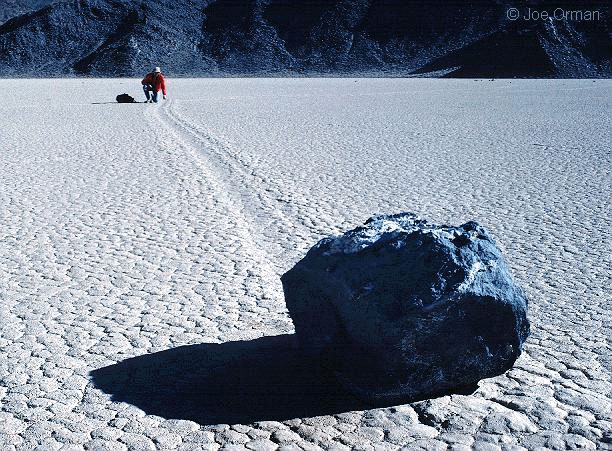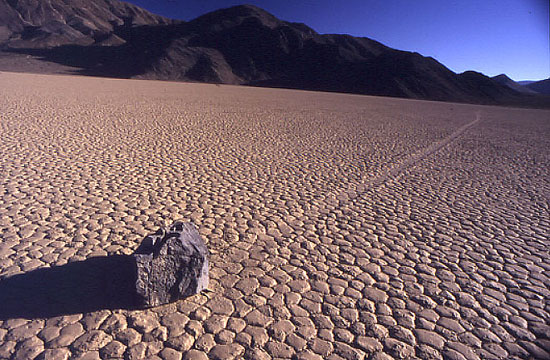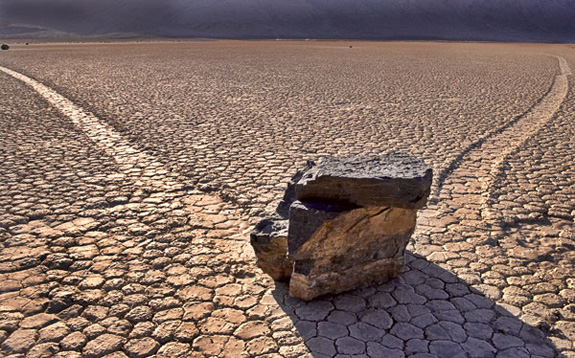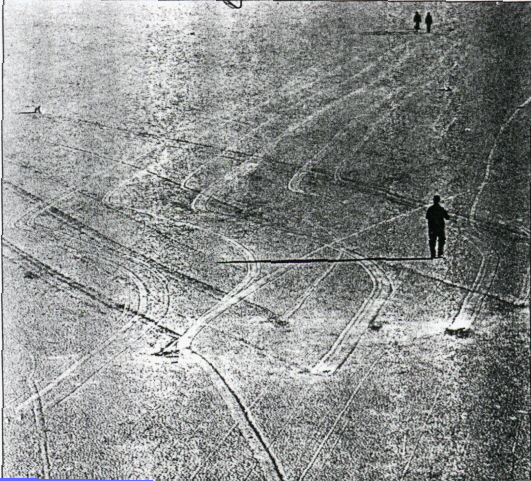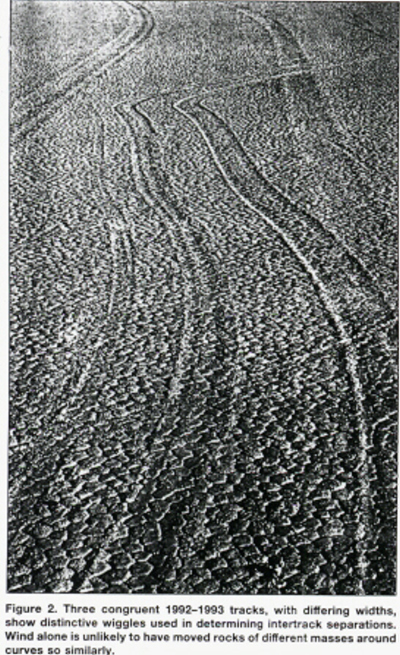|
The Enigmas on Earth |
||||
|
..
In a remote corner of California's Death Valley National Park, on the floor of a dry lake bed called Racetrack Playa, can be seen the geological oddity of the sliding stones. While the force of gravity easily explains how dozens of rocks -- weighing up to 700 pounds -- could have fallen from the adjacent hillsides onto the margins of this long vanished ancient lake, it cannot explain how the rocks have moved far out onto the perfectly flat surface. No one has ever seen the rocks actually move, but the evidence is indisputable: distinct tracks in the hard clay surface, some extending for hundreds of feet. Some of the grooves are arrow straight, while others curve, take sharp turns, or even make complete loops. For decades scientists have plotted the tracks, analyzed the soil, and charted the weather in an attempt to solve the mystery. All of the theories involve extremely strong winds, but they differ on the exact physical process that allows the rocks to overcome friction. Is the answer mud, water, ice -- or some combination of these? What is clear is that the Racetrack is a unique opportunity for science to explain what at first appearance seems to be completely inexplicable. - Source: EPOD |
||||
"The Racetrack had a stunning new display of "moving rocks". I haven't seen more impressive tracks behind those rocks that move across the surface of Racetrack Dry Lake in many years. Some indicated rather bizarre movement: long straight shots for 50 yards and more followed by an immediate return - only thrown off by maybe 10 degrees. Others seemed to have moved in circles. Everybody can witness the evidence of the moving rocks, however, nobody has ever actually seen them moving." - Harald Pietschmann |
||||
|
..
The Mystery of
the Rocks on the
Racetrack at Death Valley
Actively studied for 50 years, the rocks that mysteriously move around the dried lake bed playa in Death Valley, called the Racetrack, are yet to have an unquestionable explanation for their movement. In 1955 George M. Stanley first proposed the theory that the rocks move with the assistance of ice sheets forming after the playa surface is flooded. There have been times when the playa is flooded with standing water up to 7 cm deep and temperatures commonly drop below freezing at the Racetrack (elevation is 3,708 feet so it has cooler temperatures than the valley floor which has the lowest elevation and the highest recorded temperature in the western hemisphere) in the winter and early spring. In 1976 Robert Sharp and Dwight Carey disputed the acetate theory. They analyzed the tracks and concluded because of track characteristics and the geometries of the tracks relative to each other that ice sheets could not have been involved in forming the tracks and moving the rocks.
Sharp and Carey concluded due
to the non parallel nature and the crossing of
some trails that it would
be impossible for one ice sheet to be a moving
agent of these rocks. (Sharp
and Carey, Fig. 14, 1976)
Sharp and Carey also did an experiment using a circle of stakes around rocks to test the acetate theory. At one time the one rock within the stakes (called "the corral") moved out leaving a distinct track; another time two rocks were placed inside the corral and the smaller rock moved out while the larger remained within the stakes. Sharp and Carey concluded that this would be an impossible result if ice was necessary for moving the rocks. In 1976 they stated, "It is concluded that wind moves the stones when conditions are just right, that this normally happens at least every one to three years on Racetrack Playa, and that ice sheets are not necessary." (Sharp and Carey, 1976). In 1995, John B. Reid, Jr. and other geologists from Hampshire College disagreed with Sharp and Carey's conclusion. Using data from seven Death Valley visits in the late 1980s through 1994, they support Stanley's original ice sheet hypothesis. Reid et. al. compared tracks and the similarities of tracks and doing careful mapping saw that most of the tracks formed during the 2 major movement events had congruent paths. Some tended to deviate near the end of the trail and they justified this by explaining that the ice sheet would break into smaller pieces as it melted and the imbedded rocks could separate.
Reid et. al. conducted friction coefficient experiments and determined that the friction of the playa surface was so high that impossible wind speeds were necessary for wind alone to move the rocks on the playa surface. Reid also tried to explain the movement of the rock out of Sharp and Carey's corral with a breaking ice sheet theory. Reid et. al. concluded that, "Because of the strong congruence of widely spaced tracks and the rocks' high resistance to sliding in mud, we have concluded that ice sheets are necessary for Racetrack rocks to slide." (Reid et. al., 1995). This was followed by a Sharp and Carey, Reid et. al. discussion and reply in 1996. Sharp and Carey restated points about rock tracks, such as angular rocks traveled in a straighter line and rounder bottomed rocks tended to wander more with out "keels" to keep them straight; if ice sheets were involved characteristics on the bottom of the rock would have no effect on the trail. They also pointed out the criss-crossing trails and other geometries that would be difficult to explain with ice sheet movement. Sharp and Carey restated an earlier made point that the friction experiments made neglected to take into consideration a fine clay layer that forms on the playa surface after flooding, but is blown off quickly after drying and flaking. This clay layer significantly lowers the friction on the playa surface. They also disagree with the breaking ice sheet theory explaining the rock movement out of the corral. Their 1996 statement was, "Our conclusion is that both wind driven ice and wind alone can create stone tracks on playas." John Reid et. al. in 1996 replied to Sharp and Carey's discussion with agreement and revised their 1995 conclusion to, "All said, we agree with Sharp and Carey's assertion that two separate mechanisms must exist for Racetrack sliding. Are there others?" Research of the Racetrack has continued. In the April 1997 GPS World, Paula Messina, Phil Stoffer and Keith C. Clarke reported a GPS study they conducted of the Racetrack. In ten days of intense field work they mapped every featured of the playa using differential GPS to produce, "the first ever, complete, geo-referenced, submeter-resolution map of the wandering rocks." (Messina, 1997, p. 42) - SOURCE |
||||
| FAIR USE NOTICE: This page contains copyrighted material the use of which has not been specifically authorized by the copyright owner. Pegasus Research Consortium distributes this material without profit to those who have expressed a prior interest in receiving the included information for research and educational purposes. We believe this constitutes a fair use of any such copyrighted material as provided for in 17 U.S.C § 107. If you wish to use copyrighted material from this site for purposes of your own that go beyond fair use, you must obtain permission from the copyright owner. | ||||
|
|
